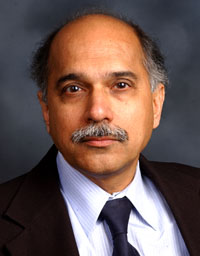 | Ramamurti Shankarr |
Ramamurti Shankar, newly named as the John Randolph Huffman Professor of Physics, is working to promote understanding of the complexities of interactions within the quantum world.
As an undergraduate at the Indian Institute of Technology in Madras, Shankar studied electrical engineering, earning his degree in 1969. Inspired by "The Feynman Lectures on Physics," a now-classic three-volume introduction to the field, he taught himself physics and entered the graduate program in elementary particle physics at the University of California at Berkeley, earning his Ph.D. there in 1974. He then moved from Berkeley, where at that time the scientists did not believe in the existence of truly elementary particles, to the Harvard Society of Fellows, where he switched to the rival school of thought that believed in the existence of quarks. While serving as a junior fellow there 1974-1977, Shankar extracted one of the first estimates of the forces between quarks.
Shortly after coming to Yale in 1977, Shankar moved to the field of statistical mechanics, focusing on exact solutions to pure and disordered systems. For the last 15 years, he has been working on applying methods of quantum field theory to problems in quantum antiferromagnets, strongly interacting electrons, the Fractional Quantum Hall Effect and quantum dots.
Shankar is author of the books "The Principles of Quantum Mechanics," originally released in 1980 and re-released in 1994, and "Basic Training in Mathematics," a 1995 book based on his Yale course "Physics 301a."
In addition to teaching Yale science students, Shankar has illuminated the field of quantum physics for non-scientific audiences in his talk "When you come to a fork in the road, take it: Yogi Berra's guide to the quantum world," which he has presented at the Aspen Center for Physics, the 2003 Yale alumni reunion and the Graduate School's "In the Company of Scholars" series.
Shankar, who came to Yale as the J.W. Gibbs Instructor of Physics and rose to a full professorship in 1988, has been chair of the Department of Physics since 2001. He has served on numerous University committees, including the Tenured Appointments Committee, the Divisional Advisory Committee (as acting chair) and the Quantitative Reasoning Committee (as chair), to name just a few.
The Yale physicist has held visiting posts at the Ecole Normale Superieure in Paris and the Institute of Theoretical Physics at the University of California at Santa Barbara. He was made a fellow of the American Institute of Physics in 2001 and an Alfred P. Sloan Fellow 1982-1986. He serves on the governing body of the Aspen Center for Physics.
T H I S
Ramamurti Shankar:
Huffman Professor of Physics
 W E E K ' S
W E E K ' S S T O R I E S
S T O R I E S![]()
 Eight Yale professors elected fellows . . .
Eight Yale professors elected fellows . . .![]()
![]()
 Undergraduates create prize to honor faculty advisers
Undergraduates create prize to honor faculty advisers
![]()
![]()
 Fake patients helping medical students to develop real-world skills
Fake patients helping medical students to develop real-world skills
![]()
![]()
 Site offers special challenges to young architects
Site offers special challenges to young architects
![]()
![]()
 Summertime at Yale
Summertime at Yale
![]()
![]()
 SOM center wins grant for study of behavioral finance
SOM center wins grant for study of behavioral finance
![]()
![]()
 FOUR FACULTY GET ENDOWED POSTS
FOUR FACULTY GET ENDOWED POSTS Charles Bailyn: Donnelley Professor of Astronomy
Charles Bailyn: Donnelley Professor of Astronomy
![]()
 Dr. Roberta Hines: Greene Professor of Anesthesiology
Dr. Roberta Hines: Greene Professor of Anesthesiology
![]()
 Dr. Margaret Hostetter: Wallace Professor of Pediatrics
Dr. Margaret Hostetter: Wallace Professor of Pediatrics
![]()
 Ramamurti Shankar: Huffman Professor of Physics
Ramamurti Shankar: Huffman Professor of Physics
![]()
![]()
 Gallery acquires collection of Mediterranean coins
Gallery acquires collection of Mediterranean coins
![]()
![]()
 Alumni return to campus to celebrate reunions
Alumni return to campus to celebrate reunions
![]()
![]()
 AYA honors five for outstanding service with Yale Medals
AYA honors five for outstanding service with Yale Medals
![]()
![]()
 Graduate School presents alumni with its highest honor
Graduate School presents alumni with its highest honor
![]()
![]()
 Three faculty members are hailed by graduate students . . .
Three faculty members are hailed by graduate students . . .
![]()
![]()
 Researchers solve riddle of what makes some mammals . . .
Researchers solve riddle of what makes some mammals . . .
![]()
![]()
 Study will compare treatments for children with type 2 diabetes
Study will compare treatments for children with type 2 diabetes
![]()
![]()
 Susan Greenberg named the first Goldsmith Assistant Curator
Susan Greenberg named the first Goldsmith Assistant Curator
![]()
![]()
 Prize-winning series of articles cites Yale research
Prize-winning series of articles cites Yale research
![]()
![]()
 Athletics department staff go to bat for a worthy cause
Athletics department staff go to bat for a worthy cause
![]()
![]()
 Scientist Michel Devoret is honored . . .
Scientist Michel Devoret is honored . . .
![]()
![]()
 Campus Notes
Campus Notes
![]()
![]()
 Concert to feature undergraduate musicians
Concert to feature undergraduate musicians
![]()
![]()
 2004 Commencement Information
2004 Commencement Information![]()
Bulletin Home |
| Visiting on Campus
Visiting on Campus |
| Calendar of Events
Calendar of Events |
| In the News
In the News![]()
Bulletin Board |
| Classified Ads
Classified Ads |
| Search Archives
Search Archives |
| Deadlines
Deadlines![]()
Bulletin Staff |
| Public Affairs
Public Affairs |
| News Releases
News Releases |
| E-Mail Us
E-Mail Us |
| Yale Home
Yale Home